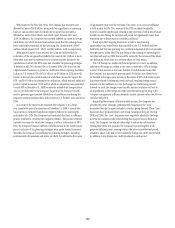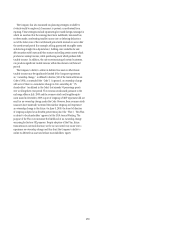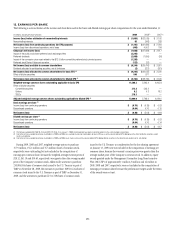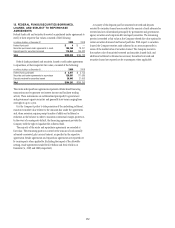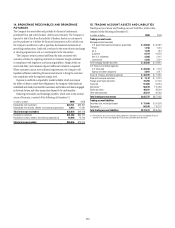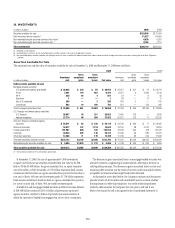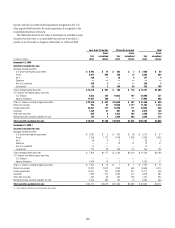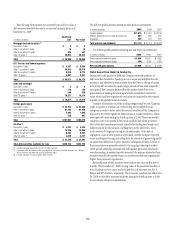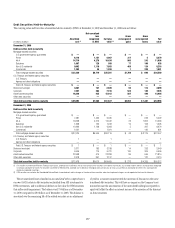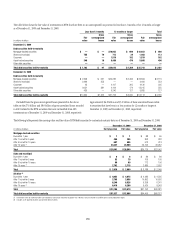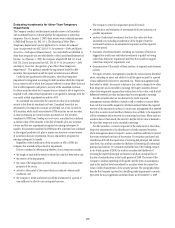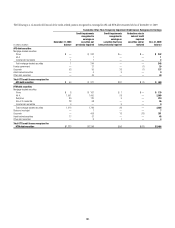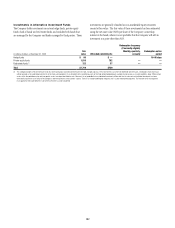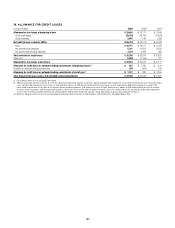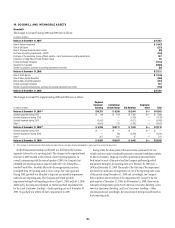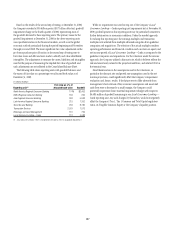Citibank 2009 Annual Report Download - page 189
Download and view the complete annual report
Please find page 189 of the 2009 Citibank annual report below. You can navigate through the pages in the report by either clicking on the pages listed below, or by using the keyword search tool below to find specific information within the annual report.179
Evaluating Investments for Other-Than-Temporary
Impairments
The Company conducts and documents periodic reviews of all securities
with unrealized losses to evaluate whether the impairment is other than
temporary. Prior to January 1, 2009, these reviews were conducted pursuant
to FASB Staff Position No. FAS 115-1, The Meaning of Other-Than-
Temporary Impairment and its Application to Certain Investments
(now incorporated into ASC 320-10-35, Investments—Debt and Equity
Securities—Subsequent Measurement). Any unrealized loss identified as
other than temporary was recorded directly in the Consolidated Statement of
Income. As of January 1, 2009, the Company adopted FSP FAS 115-2 and
FAS 124-2 (now incorporated into ASC 320-10-35-34, Investments—Debt
and Equity Securities: Recognition of an Other-Than-Temporary
Impairment). This guidance amends the impairment model for debt
securities; the impairment model for equity securities was not affected.
Under the new guidance for debt securities, other-than-temporary
impairment is recognized in earnings for debt securities which the Company
has an intent to sell or which the Company believes it is more-likely-than-not
that it will be required to sell prior to recovery of the amortized cost basis.
For those securities which the Company does not intend to sell or expect to be
required to sell, credit-related impairment is recognized in earnings, with the
non-credit-related impairment recorded in AOCI.
An unrealized loss exists when the current fair value of an individual
security is less than its amortized cost basis. Unrealized losses that are
determined to be temporary in nature are recorded, net of tax, in AOCI for
AFS securities, while such losses related to HTM securities are not recorded,
as these investments are carried at their amortized cost. For securities
transferred to HTM from Trading account assets, amortized cost is defined
as the fair value of the securities at the date of transfer, plus any accretion
income and less any impairment recognized in earnings subsequent to
transfer. For securities transferred to HTM from AFS, amortized cost is defined
as the original purchase cost, plus or minus any accretion or amortization
of a purchase discount or premium, less any impairment recognized in
earnings subsequent to transfer.
Regardless of the classification of the securities as AFS or HTM, the
Company has assessed each position for impairment.
Factors considered in determining whether a loss is temporary include:
the length of time and the extent to which fair value has been below cost; •
the severity of the impairment; •
the cause of the impairment and the financial condition and near-term •
prospects of the issuer;
activity in the market of the issuer which may indicate adverse credit •
conditions; and
the Company’s ability and intent to hold the investment for a period of •
time sufficient to allow for any anticipated recovery.
The Company’s review for impairment generally entails:
identification and evaluation of investments that have indications of •
possible impairment;
analysis of individual investments that have fair values less than •
amortized cost, including consideration of the length of time the
investment has been in an unrealized loss position and the expected
recovery period;
discussion of evidential matter, including an evaluation of factors or •
triggers that could cause individual investments to qualify as having
other-than-temporary impairment and those that would not support
other-than-temporary impairment; and
documentation of the results of these analyses, as required under business •
policies.
For equity securities, management considers the various factors described
above, including its intent and ability to hold the equity security for a period
of time sufficient for recovery to amortized cost. Where management lacks
that intent or ability, the security’s decline in fair value is deemed to be other
than temporary and is recorded in earnings. AFS equity securities deemed
other-than-temporarily impaired are written down to fair value, with the full
difference between fair value and amortized cost recognized in earnings.
For debt securities that are not deemed to be credit impaired,
management assesses whether it intends to sell or whether it is more-likely-
than-not that it would be required to sell the investment before the expected
recovery of the amortized cost basis. In most cases, management has asserted
that it has no intent to sell and that it believes it is not likely to be required to
sell the investment before recovery of its amortized cost basis. Where such an
assertion has not been made, the security’s decline in fair value is deemed to
be other than temporary and is recorded in earnings.
For debt securities, a critical component of the evaluation for other-than-
temporary impairments is the identification of credit impaired securities,
where management does not expect to receive cash flows sufficient to recover
the entire amortized cost basis of the security. For securities purchased and
classified as AFS with the expectation of receiving full principal and interest
cash flows, this analysis considers the likelihood of receiving all contractual
principal and interest. For securities reclassified out of the trading category
in the fourth quarter of 2008, the analysis considers the likelihood of
receiving the expected principal and interest cash flows anticipated as of
the date of reclassification in the fourth quarter of 2008. The extent of the
Company’s analysis regarding credit quality and the stress on assumptions
used in the analysis have been refined for securities where the current fair
value or other characteristics of the security warrant. The paragraphs below
describe the Company’s process for identifying credit impairment in security
types with the most significant unrealized losses as of December 31, 2009.


